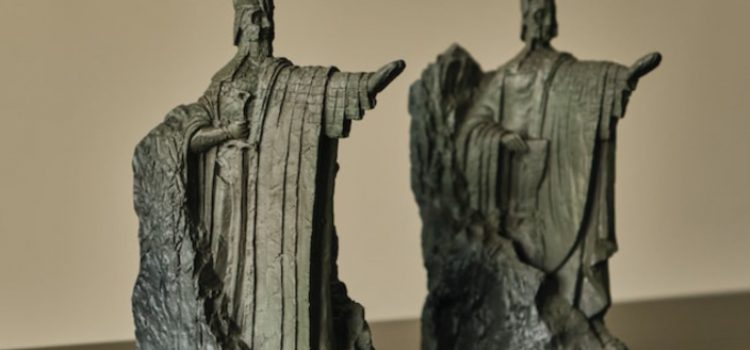

This article gives you a glimpse of what you can learn with Shortform. Shortform has the world’s best guides to 1000+ nonfiction books, plus other resources to help you accelerate your learning.
Want to learn faster and get smarter? Sign up for a free trial here .
Who is Aragorn from The Lord of the Rings, really? What makes a mere ranger from the wilderness an heir to the throne of both Gondor and Arnor? Is Aragorn part elf?
If you only watched the films, you probably know that Aragorn is a son of Arathorn, and a descendant of Isildur, making him an heir to the throne of Gondor. But that’s about it. To be fair, explaining Aragorn’s family tree would probably be too much for a film, especially for an “uninitiated audience.”
We’ve done some research into Aragorn’s family tree to understand what makes a mere ranger an heir to the thrones of the two greatest kingdoms of Men in Middle-Earth.
Aragorn’s Journey in The Lord of the Rings
Before we dive into Aragorn’s family tree, here’s a little refresher on the character. Aragorn is a protagonist in Tolkien’s trilogy The Lord of the Rings. He comes into the scene rather unassumingly as a ranger from the wilderness, sent by the wizard Gandalf to guide Frodo and Sam on their journey to the Rivendell.
In Rivendell, Aragorn’s true identity is revealed at the Council of Elrond. It turns out that Aragorn is “no mere ranger,” but an heir of Isildur and thus the rightful heir to the throne of Gondor, a kingdom of Men in Middle Earth.
Aragorn volunteers to aid Frodo on his quest to take the Ring to Mordor to destroy it, along with eight other companions led by Gandalf. After Gandalf’s fall in Moria, Aragorn takes charge of the fellowship and leads it until they stop to camp at the Parth Galen above the Falls of Rauros. There, the company is split after being attacked by orcs.
After the breaking of the fellowship, Aragorn leads Gimli and Legolas in the pursuit of the orcs who kidnapped Merry and Pippin. The pursuit brings them to Fangorn forest, where they meet resurrected Gandalf, who tells them that the hobbits are fine. Then they set off to the kingdom of Rohan.
In Rohan, Aragorn successfully leads the battle of Helm’s Deep and persuades King Theoden to aid Gondor in the upcoming battle with Sauron. After defeating Sauron’s forces in Gondor, Aragorn leads an army of both Gondor and Rohan to the Black Gate of Mordor to distract Sauron’s Eye so Frodo and Sam can get to Mount Doom unnoticed.
In the end, Gandalf crowns Aragon the king of Gondor and Arnor, and he takes the Arwen’s hand in marriage.
Aragorn’s Family Tree
To trace Aragorn’s family tree and how it unfolded throughout the ages, it’ll be helpful to first understand the story of the rise and fall of the kingdom of Númenor, as this is where Aragorn’s kingly lineage takes root.
Númenor was a civilization of Men occupying a large island to the west of Middle-Earth. The Valar (the angels or lesser gods who shaped and governed Arda, the material realm) lifted the island up from the depths of the sea as a gift to Men for their fight in the war against Morgoth.
Elros, the twin brother of Elrond, became the first king of Númenor, marking the beginning of Aragorn’s kingly lineage. Elros was approximately the 63rd great-grandfather to Aragorn. This also means that Elrond was his equally distant great-uncle, making Arwen (his wife) his first cousin, 64 times removed.
Since Elros and Elrond were Half-elven, they were given a choice of their destiny, meaning they got to choose whether they’d be counted towards Elves or towards Men. The two brothers made opposite choices: Elrond chose to be counted towards Elves, while Elros chose mortality or the Gift of Men. However, the Valar afforded Elros an extraordinarily long lifespan, greater than that of an average man, which explains Aragorn’s longevity.
Elros ruled for 410 years and died at exactly 500 years of age. After Elros’s passing, Númenor was ruled by his descendants for almost 3,000 years of the Second Age until the Downfall of Númenor. However, the line of the House of Elros did not end with the kingdom. Elros’s royal lineage continued through his great-great-grandson Meneldur. Another branch of the line also survived: the Lords of Andúnië, descended from Silmariën. (Although Silmariën was older than Meneldur, she didn’t inherit the throne because the laws of Númenor didn’t allow women to rule as queens).
The line of the Lords of Andúnië continued down to Elendil, who became the first king of Gondor and Arnor—the two realms established by the surviving Númenorians. He ruled for 121 years until he was slain by Sauron in the War of the Last Alliance in the late Second Age.
Elendil was succeeded by his eldest son Isildur, who cut the One Ring from Sauron’s hand. Isildur’s son Valandil then became the king of Arnor, but he didn’t claim the throne of Gondor, and the two kingdoms separated. Gondor continued to be ruled by the heirs of Anárion, Isildur’s younger brother, while Arnor was ruled by the heirs of Isildur. Since Aragorn was the direct descendant of Isildur (39th, to be exact), he was the rightful heir to the thrones of both kingdoms. At the end of the Third Age, Aragorn reunited Gondor and Arnor.

Want to fast-track your learning? With Shortform, you’ll gain insights you won't find anywhere else .
Here's what you’ll get when you sign up for Shortform :
- Complicated ideas explained in simple and concise ways
- Smart analysis that connects what you’re reading to other key concepts
- Writing with zero fluff because we know how important your time is






